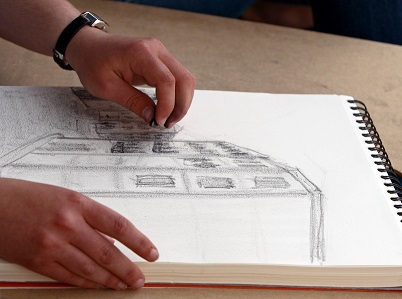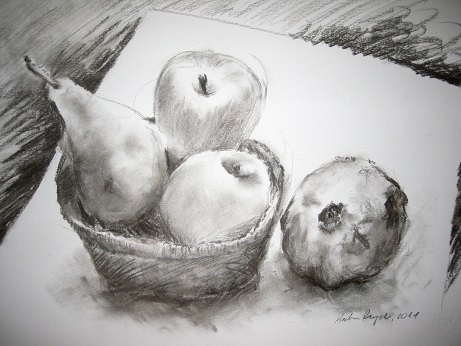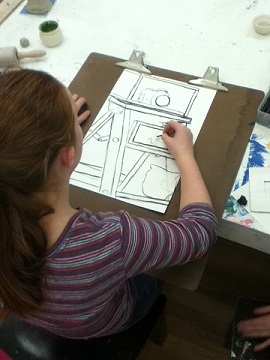
For years, Continuing Education art students have known Gary Georger as a ceramics instructor and studio potter, but he actually began his art studies with drawing and painting. He hopes to share this passion with students in his forthcoming class, Charcoal Drawing. “I fell into pottery as I was pursuing a BFA in painting at New Paltz University in New York,” he recalls. “I had never given up on drawing, as it is an intricate tool as an artist and designer. I have always enjoyed the sketchbook—sketching ideas, landscapes, whatever may come to mind. As studio potter I was never far away from painting.”
While living in Ho Chi Minh City, Georger established a cooperative studio where he could again focus on painting. “I drew and painted the landscape or interpretations of my surroundings,” he says. “I was invited to show this work at the Ho Chi Minh Art Museum, Saigon. Currently I am busy in the studio making pots and have a few canvases in the works as well.”
Georger says students enrolling for Charcoal Drawing can look forward to working in a space not unlike his ceramics classes in tone. “My classrooms are always community-based classrooms,” he says. “I don't believe in the hierarchy of teacher/student. I'm more inclined to take the knowledge of the individuals in the classroom and share that knowledge within the room. I create a giving and open environment as a creative space to share and grow. This way, we have a multitude of teachers, if you will, in the space.”
According to Georger, students new to the charcoal medium will be encouraged to approach it much as they would clay. “Charcoal is a very forgiving and very pliable material,” he says. “Pushing and pulling the charcoal gives you a freedom of exploration and allows you to be creative without the threat of permanency.”
Students new to charcoal will start their exploration on still-life drawings and the foundations of 2-D design. “We explore will aspects and skills of size, scale and proportion, introducing techniques to view and create both realism and abstractions,” says Georger. “As a community we will see how the classroom organically finds itself with different levels of students and enjoy an evening working in charcoal.”
A big part of mastering the charcoal medium is in raising one’s understanding of the additive and reductive process of utilizing light and shadow. “As mentioned before, the charcoal is a very plastic and forgiving medium,” says Georger. “The additive process of charcoal drawing is simply applying the charcoal in various ways to achieve different values, surfaces and textures. This is very much like drawing with any other medium. The reduction process is drawing the light by establishing dark areas and using the eraser as a drawing tool, erasing the light forms out. We continue to expand our values as we push and pull the medium.”
Best of all, any mistakes made in charcoal are easily wiped off the paper. “You can go back to redefine and reestablish,” says Georger. “You keep searching and reinstating the forms until you achieve your finished results. The speed and energy of the work as a tactile medium just brings out wonderful tonal values and wonderful expressive drawings.”
 Georger says he looks forward to the inspiration students take away from his class. “I hope they walk away with a sense of accomplishment with their new skills. A drawing or two that they may proudly hang with competence and confidence and a newfound appreciation of the possibilities in charcoal drawing.”
Georger says he looks forward to the inspiration students take away from his class. “I hope they walk away with a sense of accomplishment with their new skills. A drawing or two that they may proudly hang with competence and confidence and a newfound appreciation of the possibilities in charcoal drawing.”
Learn more about Charcoal Drawing.
Photo credit #2: Andrea Rugarli_cc_2.0
Photo credit #3: Studio Art 4_cc_2.0